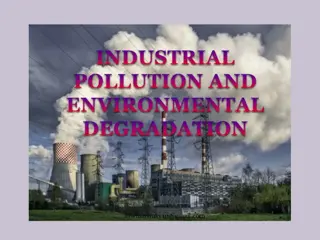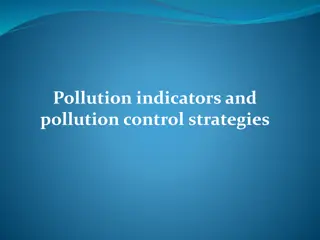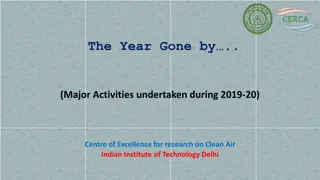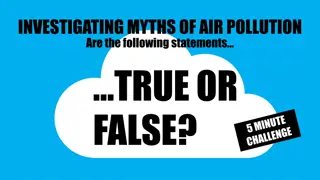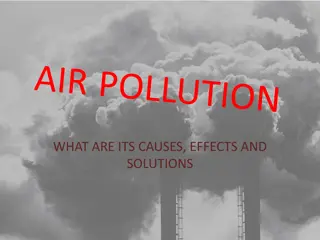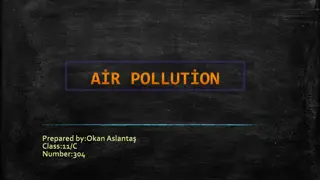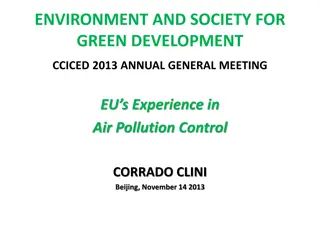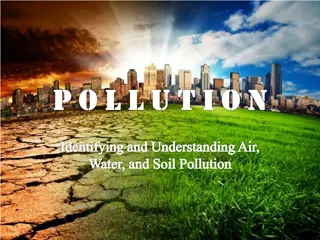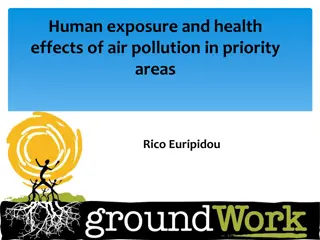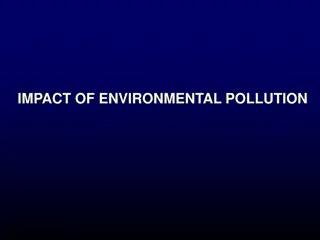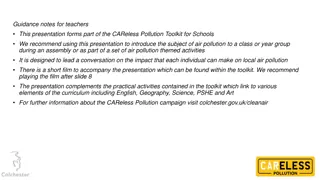Understanding Air Composition and Pollution
The composition of the dry atmosphere by volume, primary and secondary pollutants, and the impact of human activities on air quality are discussed. Various gases present in the atmosphere, sources of pollution, and the belief that natural elements are clean until polluted are explored. Different natural and human-induced events contributing to pollution are highlighted, with a focus on major pollutants from mobile sources. The content emphasizes the importance of environmental preservation and awareness to combat air pollution.
Download Presentation

Please find below an Image/Link to download the presentation.
The content on the website is provided AS IS for your information and personal use only. It may not be sold, licensed, or shared on other websites without obtaining consent from the author. Download presentation by click this link. If you encounter any issues during the download, it is possible that the publisher has removed the file from their server.
E N D
Presentation Transcript
Composition of dry atmosphere, by volume ppmv: parts per million by volume Gas Nitrogen (N2) Oxygen (O2) Argon (Ar) Carbon dioxide (CO2) Neon (Ne) Helium (He) Methane (CH4) Krypton (Kr) Hydrogen (H2) Not included in above dry atmosphere: Water vapor (highly variable) Volume 780,840 ppmv (78.084%) 209,460 ppmv (20.946%) 9,340 ppmv (0.9340%) 375 ppmv 18.18 ppmv 5.24 ppmv 1.745 ppmv 1.14 ppmv 0.55 ppmv typically 1% Mean Atmospheric Water Vapor. Source for figures above: NASA. Carbon dioxide and methane updated (to 1998) by IPCC TAR table 6.1 [1]. The NASA total was 17 ppmv over 100%, and CO2 was increased here by 15 ppmv. To normalize, N2 should be reduced by about 25 ppmv and O2 by about 7 ppmv. Minor components of air not listed above include: Gas nitrous oxide xenon ozone nitrogen dioxide iodine carbon monoxide trace Volume 0.5 ppmv 0.09 ppmv 0.0 to 0.07 ppmv 0.02 ppmv 0.01 ppmv
Air pollution may be defined as the presence in the air of one or more contaminants in such quantities and of such durations that may be injurious to human, animal or plant life, or which interferes with the comfortable enjoyment of life A pollutant can be solid (large or sub- molecular), liquid or gas
Primary & Secondary Pollutants Primary: emitted directly into air : Carbon monoxide (58%) Nitrogen oxides (15%) Sulfur oxides (13%) Volatile organic compounds VOCs (11%) Particulates (3%) Secondary: produced thru reactions (ozone)
Many people believe that soil, water, and air in a so-called natural state are clean and good and become bad only if people contaminate and pollute them
Many natural events, including dust storms, floods, and volcanic processes, can introduce materials harmful to humans and to other living things into the soil, water, and air Pollution happens because no process is 100% efficient; each process produces pollution (waste) and waste energy
The biggest contributors to air pollution are mobile sources (e.g. cars, trucks, buses, planes). Carbon monoxide (CO), carbon dioxide (CO2), and nitrogen oxides (NOx) represent the largest portion of pollutants
Major Air Pollutants: Sulfur Dioxide (SO2) Converts into particulate sulfate (SO4) in atmosphere Produced by fossil fuel combustion (coal), petroleum refinement, cement, aluminum, and paper production Corrosive to paints and metals Plant damage (esp alfalfa, cotton, barley) Lung damage ACID RAIN precursor
Nitrogen Oxides (NOX) Nitric oxide (NO) and nitrogen dioxide (NO2) It can lead to smog and acid rain Source: automobiles and power plants Suppress plant growth in air; but as nitrate form in soil, it is a fertilizer Eye, lung irritation; increased susceptibility to infections, e.g. influenza
Acid Rain is a result of industries and cars burning oil and coal and sending sulfur dioxide and nitrogen oxides high into the atmosphere. While in the air they mix with water vapor and turn into sulfuric and nitric acids. Eventually, this harmful acid returns to earth in rain, hail, fog, or snow.
This acid damages plant life and may eventually kill insects, frogs, and fish in our waters Acid rain is a worldwide problem because it can be carried in the atmosphere for great distances before falling back to earth.
Carbon Monoxide (CO) colorless, odorless, extremely toxic CO gets locked on hemoglobin in blood 250 x faster than O2, leading to hypoxia Do not burn camping stove in a tent Repair car exhaust leaks into your car Most emissions through tailpipes of vehicles Recent reductions due to cleaner burning engines
Ozone (O3) natural O3 in stratosphere: good anthropogenic O3 at surface: bad produced near surface by: photochemical reaction, i.e. sunlight + NO2 -> O3 more readily oxidizes (burns) things than O2 used to purify water (kill bacteria) very damaging to plants.
VOCs Volatile Organic Compounds (VOCs) Primary source: automobiles Can cause smog, toxic to plants & animals
Particulate Matter smoke, soot, dust Agriculture is a considerable source, as is industry particles smaller than 10 m e.g. Heavy metals, arsenic, copper, lead, zinc, and asbestos emitted by industrial activities are harmful. particles smaller than 2.5 m are Easily inhaled and absorbed in blood stream = harmful Most significant are sulfates & nitrates, secondary Pollutants
Total suspended particulates : TSPs TSPs tend to be higher in developing nations and in large cities Globally, 2-9% mortality associated with TSPs 60,000 deaths in USA Annually Block sunlight to Earth
Smog 1- Photochemical smog (brown air) Solar radiation is important Directly related to automobile use
2. Sulfurous smog (London-type; industrial; grey air)
INDOOR AIR Inadequate ventilation can increase indoor pollutant levels by not bringing in enough outdoor air to dilute emissions and by not carrying indoor air pollutants out. indoor levels of many pollutants may be 2-5 times higher than outdoor levels. These levels of pollutants are of particular concern because it is estimated that most people spend as much as 90% of their time indoors esp. for babies and seniors, people with compromised health.
sources of indoor air pollution combustion sources (e.g. tobacco products, oil, gas, coal, wood) building materials and furnishings (e.g. asbestos, off- gassing of formaldehyde); products for household cleaning or hobbies (e.g. glue) outdoorsources (e.g. outdoorair pollution, radon, pesticides).
Health effects from indoor air pollutants Health effects from indoor air pollutants may be experienced soon after exposure, or possibly years later. Short-term effects may include headaches, dizziness, fatigue, and irritation of the eyes, nose or throat. Long-term effects may include respiratory diseases, heart disease and cancer.



